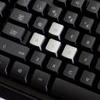Functional Usage & Software
Functional Usage & Software
As we always do, a little history first. Keyboards have always been a part of computing since the very beginning. The original IBM PC came with one, the Model M, which I used as a kid. The Model M, of course, set the standard for all keyboards that came after it. There are some variations in layout, but it's all based off the 101-key Model M. The modern keyboard, thanks to Windows, now has 104 keys, and depending on your location, you can have many more keys than that.
Suffice it to say, keyboards are still the most efficient way of interacting with your computer, even with the great strides made in voice-recognition, touch screens, and GUI optimizations. I think the chances of humans ever growing out of the keyboard are pretty slim. In the early days of personal computing the keyboard really meant something because it really was the only way to interact with the machine. Having a good-feeling keyboard was very important, at least until the mouse and GUI came along, and shifted the focus a little bit. Mechanical keyboards have always been around, though, part of the collective geek consciousness, and the enthusiasts that inhabit that world are as hardcore as their keyboards.
Corsair chose to keep the features a little more basic with the Raptor series. And sure, you don't need a fancy mechanical keyboard to play a game well. On the other hand, there are keyboards that are better for noise than others.
The software suite:
The basic functions are pre-built into the software so you can assign the more obvious ones if you desire. You can program up-to 18 keys per profile. The K40 uses the software for macro programming (though you can program on-the-fly from the board itself too), and a key feature to note is Hardware Playback mode. Essentially, this bypasses the software and runs the macro direct from on-board memory. Some games, including BF4 and Skyrim, block software macros, so this is a rather handy "feature". You do need to remember to store the profile in the software though, and only one profile can be stored at a time in Hardware Playback mode.
Recording a macro is as simple as pressing the MR button, selecting the memory bank (M1, M2 or M3) and key to record to and getting on with it. Once you've finished press MR again and you can then tweak it still further if you wish to. The functionality has to be one of the simplest systems we've ever worked with, and we like simplicity alright.
And with thay array of RGB Led backlight options Corsair certainly added some nice Backlight features.




